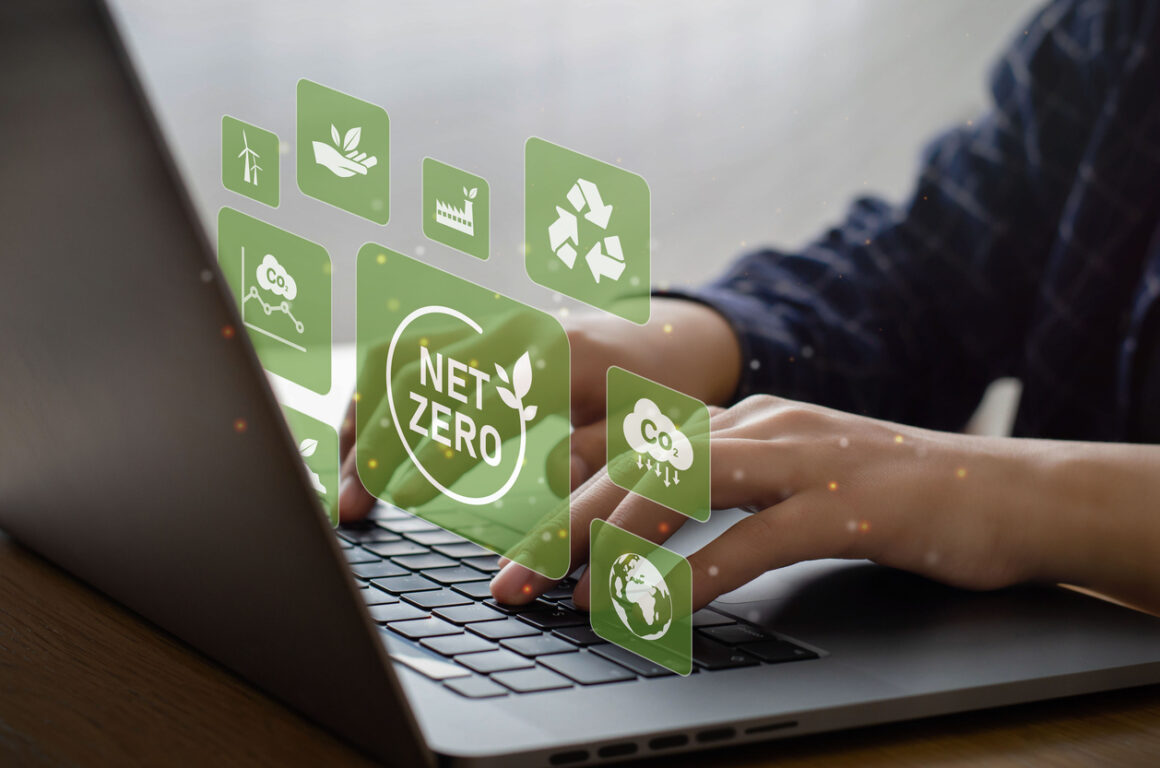Sustainable websites: how to optimise your website for sustainability
As the tech industry becomes increasingly accountable for its environmental responsibilities, the focus on website sustainability and the need for eco-friendly websites has intensified. This shift responds to environmental concerns. It is a strategic imperative for organisations aiming to future-proof their operations and align with consumer expectations for eco-friendly, sustainable web development practices.

Index
- The imperative for sustainable websites built with green software has never been more critical.
- The strategic importance of sustainable websites
- Implementing green software development practices: a guide for leaders
- Efficient coding practices
- Optimising images and media for marketing impact
- Choosing green sustainable web hosting
- Reducing energy consumption through smart IT infrastructure
- Leveraging green certifications for brand and member engagement
- Leadership in green software implementation
- Conclusion
TL;DR summary:
- Sustainable websites and green software are becoming essential as digital infrastructure contributes significantly to global carbon emissions and consumers increasingly expect eco-friendly practices.
- Green Software Foundation standards and tools help organisations reduce the carbon footprint of software through efficient coding, optimised media, smart infrastructure, and renewable-powered hosting.
- Sustainable web development improves speed, efficiency, operational costs, compliance readiness, and brand reputation, making it both an environmental and strategic business advantage.
- Leaders play a critical role by setting clear sustainability goals, empowering teams with training, fostering cross-department collaboration, and leveraging green certifications to build trust and engagement.
- Embracing green software practices today positions organisations as forward-thinking, responsible innovators, creating digital experiences that support long-term environmental health.
The imperative for sustainable websites built with green software has never been more critical.
The momentum building towards best practices for building environmentally responsible, green software addresses pressing global environmental challenges and aligns with increasing consumer demand for sustainable business practices.
The Green Software Foundation stands at the forefront of this movement, dedicated to establishing a robust ecosystem of standards, tooling, and best practices for sustainable software development. With the backing of industry giants and environmental advocates, the foundation aims to redefine the software development lifecycle.
The Green Software Foundation’s goal is to ensure that software contributes positively to our planet’s health, encouraging a collaborative effort among green software development, sustainable website developers, corporations, and policymakers to lower the carbon emissions tied to software dramatically.
Embracing green software practices offers a strategic advantage, enabling innovation, reducing costs, and enhancing brand reputation in a market that increasingly values sustainability.
Delving into the principles and methodologies of green software and how to build and maintain sustainable websites reveals that this change is more than just technological advancement; it’s about demonstrating leadership in sustainability.
By committing to these sustainable website and green software development practices, the tech industry can set new standards for the future, ensuring that our digital world supports the well-being of our natural one.
The strategic importance of sustainable websites

The digital infrastructure that powers our websites and online services significantly contributes to global carbon emissions, often unnoticed in the broader conversation about climate change.
However, as the tech industry becomes increasingly aware of its environmental responsibilities, the focus on website sustainability has intensified. This shift is a response to environmental concerns and a strategic requirement for businesses aiming to future-proof their operations and align with consumer expectations for eco-friendly practices.
Sustainable web development involves optimising digital assets to reduce energy consumption across the data centres, networks, and devices they utilise.
For example, data centres are estimated to account for about 1.5% of the global electricity demand. While this figure might seem small, the absolute energy consumption is substantial, highlighting the need for energy-efficient green web hosting and server management practices.
Moreover, the strategic importance of adopting green software and website sustainability practices extends beyond environmental benefits. It encompasses improved operational efficiency, cost savings from reduced energy consumption, and a more ethical brand reputation.
Today’s consumers increasingly make choices based on a company’s environmental impact, making sustainability a competitive differentiator in the marketplace. Companies that proactively adopt green practices in their digital operations can leverage this as part of their brand identity, attracting customers and partners who prioritise environmental responsibility.
Furthermore, regulatory environments are evolving to encourage and sometimes mandate reduced carbon emissions and energy usage. Organisations that lead in implementing sustainable web practices will not only stay ahead of regulatory curves but also benefit from incentives designed to promote green initiatives.
A combination of environmental necessity and strategic business considerations drives the push towards sustainable website development. By prioritising green software practices, companies can contribute to a more sustainable planet and enjoy operational efficiencies, cost savings, and enhanced brand loyalty.
Implementing green software development practices: a guide for leaders

Efficient coding practices
Efficient coding practices are foundational to green software development.
By optimising their code, developers can significantly reduce the computational power required to run applications, leading to lower energy consumption. This involves refactoring and streamlining code, removing unnecessary functions, and choosing algorithms that minimise processing time and resource usage.
Leaders should encourage their teams to adopt green coding standards that prioritise efficiency and sustainability, integrating tools that automatically assess the environmental impact of code changes.
This enhances the software’s performance and aligns development practices with ecological objectives.
Optimising images and media for marketing impact
For marketing professionals, optimising images and media is critical to greening their digital assets.
High-resolution photos and videos can significantly slow down websites, increasing energy consumption for servers and end-user devices. By compressing media files, using adaptive loading techniques, and selecting high-quality formats at lower file sizes, marketing teams can improve site speed and user engagement while reducing the carbon footprint.
Implementing these practices requires a collaborative effort between marketing and IT departments to ensure that visual content supports sustainability goals and marketing objectives.
Choosing green sustainable web hosting
The choice of green web hosting services directly impacts a website’s environmental footprint.
Sustainable web hosting providers power their data centres with renewable energy sources and employ energy-efficient cooling and server technologies. IT leaders are tasked with evaluating hosting options based on their green credentials, including energy sources, energy efficiency measures, and carbon offsetting programs.
Selecting a green hosting provider demonstrates a company’s commitment to sustainable website development and can significantly reduce the carbon emissions associated with powering website operations.
Leaders should also consider the scalability and reliability of these services to ensure they meet the organisation’s needs without compromising performance.
Reducing energy consumption through smart IT infrastructure
Adopting innovative IT infrastructure practices is essential for reducing energy consumption.
This includes implementing server virtualisation to maximise hardware utilisation, employing dynamic scaling to adjust resources based on demand, and optimising data storage strategies.
IT managers should also explore using Content Delivery Networks (CDNs) to reduce latency and energy use by caching content closer to users.
Organisations can significantly lower their IT energy use by investing in energy-efficient hardware and adopting cloud services that prioritise sustainability. Business leaders are crucial in championing these initiatives, ensuring that IT infrastructure decisions are made with both performance and environmental impact in mind.
Leveraging green certifications for brand and member engagement
Green certifications, such as the LEED certification for data centres or the Energy Star rating for IT equipment, are powerful tools for demonstrating a company’s commitment to sustainability.
Marketing and membership directors can leverage these certifications in their communication strategies to enhance brand reputation and engage environmentally conscious consumers and members.
Displaying green badges on websites and marketing materials highlights an organisation’s sustainability efforts and encourages industry peers to follow suit. The Green Web Foundation offers a free verification service. If your website passes the Green Web Check, you can display their badge to show the world you are green.
Leaders should prioritise obtaining and promoting these certifications, as they provide a tangible way to communicate the organisation’s environmental achievements and commitment to potential customers, partners, and members, fostering a community of sustainability-minded stakeholders.
Leadership in green software implementation

Leadership is pivotal in successfully implementing green software practices within an organisation.
CTOs, IT Directors, and other senior leaders are responsible for championing and strategically integrating sustainability into the core of their business operations. This commitment must be communicated clearly and consistently, setting the tone for an organisational culture that values and priorities environmental responsibility.
The first step in leading this change is establishing clear sustainability goals aligned with the organisation’s mission and values. These goals should be SMART (specific, measurable, achievable, relevant, and time-bound), ensuring they can effectively guide the organisation’s green software initiatives.
Leaders must also ensure these goals are integrated into the broader business strategy, demonstrating how sustainability contributes to the organisation’s overall success.
Education and empowerment are crucial components of leadership in green software implementation. This involves providing teams with the resources and training to understand and adopt green software practices. Leaders should encourage innovation and experimentation, allowing teams to explore new tools, technologies, and methodologies that can reduce the environmental impact of their development work.
Leaders must foster collaboration across departments and external partners to amplify their sustainability efforts. By working together, organisations can share best practices, learn from each other’s experiences, and collectively push the industry towards more sustainable practices.
Ultimately, leadership in green software implementation is about making a long-term investment in the planet’s future. By taking decisive action today, leaders can ensure their organisations contribute positively to environmental sustainability, setting an example for others to follow.
Conclusion
The journey towards more green software and website sustainability is necessary and a huge opportunity for today’s businesses.
As we have explored, the strategic importance of adopting environmentally responsible green software and sustainable website development practices extends far beyond mere compliance or cost savings. It touches on how organisations can thrive in a future where sustainability is a core consumer expectation and a critical component of business strategy.
Technology, marketing, and management leaders are uniquely positioned to drive this change.
By prioritising efficient coding practices, optimising digital assets, selecting sustainable, green hosting solutions, and leveraging green certifications, they can significantly reduce their organisations’ environmental impact while enhancing brand reputation and customer loyalty.
The path to sustainability is a collective journey that requires commitment, innovation, and leadership. As the tech industry continues to evolve, the principles of green software development provide a roadmap for creating digital solutions that meet the present’s needs and safeguard our planet’s well-being for future generations.
In embracing these practices, organisations contribute to a more sustainable world and position themselves as forward-thinking leaders in the digital age.
The time to act is now, and the opportunity to make a lasting impact is immense.
Let us lead purposefully, championing sustainability in every line of code we write and every digital experience we create.
If you’d like to discuss how we could help you with your green software and website sustainability, contact us today to arrange a call.
Further reading and resources
Below are a few other green software and sustainable web development resources you might find helpful:
- Green Software Foundation: Dive into the mission and work of leading the software industry towards sustainability. Start with their foundational article on what constitutes green software at What is Green Software?
- B Corp: Businesses can apply for a B Corp Certification as a designation that they are meeting high standards of verified performance, accountability, and transparency across the company’s entire social and environmental impact. B Corp.
- The Website Carbon Calculator: Calculate your website’s carbon footprint and discover ways to improve its sustainability at Website Carbon.
- Google’s Guide to Green Software: An extensive guide by Google on adopting green software practices within your organisation. Access it at Google Cloud.
- TechTarget’s Definition of Green Software: Provides a comprehensive overview of what green software is and its importance. Read more at TechTarget.
